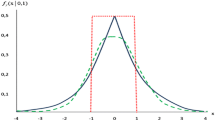Abstract
This paper examines a scheme of economic incentives for environmental protection, in which spatially differentiated pollution taxes are in use in compensating the pollution abatement costs. A simple mathematical model is described which determines an incentive system that encourages polluters to reduce the discharges to an acceptable level of ambient quality standards in a “cost-effective” manner. It is shown that the vector of pollution charges has to be proportional to the marginal abatement cost vector, but is smaller than the latter in magnitude. It is demonstrated that a necessary incentive effect may be achieved even if the total pollution charge is much lower (about three times) than the total abatement costs. It is also estimated how this charge incentive system reconciles conflicting criteria of cost-effectiveness and of equity. These conclusions are verified by numerical experiments with real data.
Similar content being viewed by others
References
Baumol, W. J. and W. E. Oates (1979), Economics, Environmental Policy and Quality of Life, New York: Prentice-Hall, 1979, 377 pp.
Bongaerts, J. C. and R. A. Kraemer (1989), ‘Permits and Effluent Charges in the Water Pollution Control Policies of France, West Germany and the Netherlands’, Environmental Monitoring and Assessment 12, 127–147.
Gofman, K. G. (1991), ‘Environmental Economy Mechanism in Transition Period’, Economika i matematicheskie metodi (Economic and Mathematical Methods) XXVII(2) (in Russian).
Kolosov, V. A. and K. I. Bibanov (1991), ‘International River Basins: Geographical Aspects’, Geografia i Prirodnie Resursi 1, 17–23 (in Russian).
Loucks, D. P., D. R. Stedinger, and D. H. Haith (1981), Water Resources Systems Planning and Analysis, Prentice Hall, 559 pp.
Modelling of Water Quality in Hydrological Cycle (1978), Proc. of joint IIASA and IAHS Symp. in Baden, Baden, 1978, 382 pp.
Montgomery, W. D. (1972), ‘Markets in Licenses and Efficient Pollution Control Programs’, J. Economic Theory 5, 395–418.
Muraro, G. (1978), ‘On Bribes and Subsidies for the Control of Externalities’, Revista Internationale di Scienze Economiche e Commercial XXV(4), 281–303.
Opschoor, J. B. and H. B. Vos (1989), Economic Instruments for Environmental Protection, Paris, OECD-Report.
Procedure for Water Pollution Permits Calculation (1990) (Metodika rascheta predel'no dopustimich sbrosov v vodnii ob'ekti so stochnimi vodami), Kcharkov, 113 pp. (in Russian).
Pollution Charges in Practice (1980), Paris, OECD.
Rikun, A. D. (1990), ‘A Closed-Loop Economic Incentive Scheme for Hierarchical Management Systems’, Dokladi Akademii Nauk SSSR (Soviet Math. Dokl.) 311(5), 1072–1076. (in Russian).
Rikun, A. D., Cherniaev, A. M., and Shiriak, I. M. (1991), Methods of Mathematical Modelling of Water Resources Systems for Industrial Regions, Moscow, Nauka, 1991, 160 pp. (in Russian).
Rikun, A. D. (1992), ‘Two Alternative Economic Incentive Approaches: A Comparative Analysis’, Economika i matematicheskie metodi (Economic and Mathematical Methods) 28, 147–175 (in Russian).
Suri, R. (1981), ‘Existence of Optimal Lagrange Multipliers for Certain Nonconvex Allocation Problem’, J. of Optimization Theory and Applications 34 (2), 169–196.
The Law on Environment Protection (1992), signed by B. N. El'tcin on 19 December 1991, no. 2060-1 (Rossiiskaia Gazeta, March 3, 1992) (in Russian).
Wiersma, D. (1991), ‘Static and Dynamic Efficiency of Pollution Control Strategies (A Case Study of SO2 Emission Abatement of the Dutch Electricity Sector)’, Environmental & Resource Economics 1, 63–82.
Author information
Authors and Affiliations
Rights and permissions
About this article
Cite this article
Rikun, A.D. On modeling incentive systems which utilize pollution charges for pollution abatement. Environmental and Resource Economics 2, 593–604 (1992). https://doi.org/10.1007/BF00330285
Issue Date:
DOI: https://doi.org/10.1007/BF00330285




